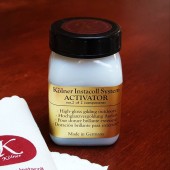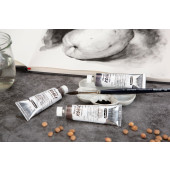Search results for 'layer stone'
-

Instacoll Gilding System
Starting at: £6.85
Kölner Instacoll is a two-part system, consisting of a base coat and activator, that can be used on nearly all suitably prepared substrates to create weather-resistant, high gloss interior and exterior gilded surfaces. The Instacoll Tool is a double-ended tool with shaped tips made of elastic rubber, designed for pressing gold and silver transfer leaf into indentations when gilding uneven surfaces. The Instacoll Chiffonnette is an extra soft, lint-free cloth, used for polishing and burnishing surfaces gilded with Instacoll. *PLEASE NOTE - COLOURS OF THESE PRODUCTS MAY VARY SLIGHTLY FROM PRODUCTS PICTURED* Learn More -

Schmincke Liquid Charcoal 15 ml
Starting at: £18.30
Liquid charcoal in the 15 ml tube - a clean, dust-free way of painting, charcoal drawing and underpainting with charcoal. The three pigments of natural origin used for this (PBK 8, pit black) are created by charring fruit seeds from the EU area and result in the following unique coal nuances: a neutral peach stone black - 18 757 a warm, brownish cherry pit black - 18 756 a cool, bluish grape seed black - 18 755 Due to the larger quantity of available paint, liquid charcoal can be used to quickly process large areas. The liquid charcoal contains the high-quality binder gum Arabic like traditional artists' watercolours (gouaches, watercolours, etc.), has a gouache-like consistency and can be diluted with water, so that different shades, structures and layer thicknesses can be achieved by different application. Depending on the substrate and the thickness of the layer, it can be wiped off by hand and removed with water. Used as thin underpainting (e.g. in oil painting), subsequent paints do not become dirty or become less dirty than with conventional charcoal underpainting due to the higher adhesion of the bound carbon pigments to the substrate. Of course, the liquid charcoal can be combined with drawing charcoal. The blurring and removability of the liquid charcoal depends on the surface of the substrate - the more even and firm the surface, the easier to change the application. Pre-tests are recommended. Learn More



